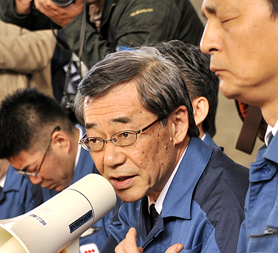Japan: Fukushima workers re-enter damaged plant
Workers at Japan’s damaged Fukushima nuclear plant have entered one of the reactor buildings for the first time since an earthquake and tsunami triggered a crippling explosion.

High radiation levels at the Fukushima plant have prevented staff from getting insde to install a new cooling system to finally bring it under control, following the devastating tsunami in Japan in March. Operator Tokyo Electric Power (TEPCO) has said it may take all year.
The company used robots to gauge the safety levels inside the reactors before sending a team back in. “They did not go inside as so-called suicide squads,” a TEPCO spokesman said. Two staff and 11 contractors were deployed wearing protective suits, masks and air tanks.
They will work in shifts of one to one-and-a-half hours, moving in and out in small groups to connect duct pipes to ventilators that will filter out 95 per cent of the radioactive material in the air, a company spokesman said.
Japan earthquake and tsunami: interactive video timeline map
“Things are moving forward steadily, one by one. Our final goal is to bring them (the reactors) to a cold shutdown. As a first step towards that, we were able to go inside the building and this is a major point,” said Junichi Matsumoto.
Cold shutdown means the water cooling the nuclear fuel rods inside reactors is below 100 degrees Celsius and the reactors are considered stable.
The ventilator system is now running and will be operated for two or three days. If the radiation level dropped after that, workers will start to install the cooling system, TEPCO officials said.
Safety risk
Initial tests on the workers show those who went inside, most of them in their 40s and 50s, were exposed to up to 2.8 millisieverts of radiation each.
Under Japanese law, nuclear plant workers cannot be exposed to more than 100 millisieverts over five years, but to cope with the Fukushima crisis, the Health Ministry raised the legal limit on March 15 to 250 millisieverts in an emergency.
Radiation of 10 to 93 millisieverts per hour was detected inside the building when two workers went inside ahead of the pipe installation works to measure radiation.
Channel 4 News special report: Japan - tsunami to nuclear crisis
Last month, Japan banned people from entering a 12 mile evacuation zone around the site. The earthquake registered at 9.0 on the Richter scale, prompting a massive tsunami which killed around 14,800 people and left more than 11,000 missing.
Thousands of homes were destroyed, while the disaster badly damaged Fukushima’s cooling reactors leading to radiation leaks.
The Fukushima plant, some 240 km (150 miles) north of Tokyo, has faced the greatest leak of radiation since the 1986 Chernobyl disaster.
Aftermath: picking up the pieces in Japan
Michael Sato, a farmer in Iwate Prefecture told Channel 4 News: "Yes, things are getting better here. They're not normal yet but life, at least for those not living in evacuation centers, is markedly better than it was two-three weeks back.
Farming has begun again. After the long winter and all the following panic and disorder, it's good to be back in a regular routine again.
In general, Hanamaki is becoming a more normal place than others. All the shops are now open again, though most on reduced hours and, like everywhere, running on less electricity. There's a lot more general food supplies in the shops too, although most of it is more expensive than before. The price of bread, for example, has doubled.
There are now signs of vegetable farmers in areas closer to Fukushima telling customers that their produce is safe to eat and that they were all grown undercover, not out in the open.
In some ways it's all very reminiscent of the UK's BSE crisis.
Whether people trust these assurances is unclear. No one I know is buying vegetables grown outside of Iwate, but then just about everyone I know is a farmer and grows their own anyway.
More from Michael Sato: Japan: life in the shadow of nuclear crisis